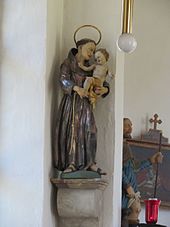St. Nikolaus (Gunzesried)
The Most Blessed Virgin and St. The chapel in Gunzesried is consecrated to Nicholas . The building dates from 1612. The rectangular building with a three-sided end and roof turret with onion dome in Talstrasse 31 was classified as a monument .
history
The first church building in Gunzesried was probably built in the 8th century by Christian missionaries from the St. Gallen monastery . This wooden structure probably fell victim to a fire. It was replaced by the stone chapel consecrated on December 12, 1612 in honor of the Most Blessed Virgin and Saint Nicholas. The Vicar General of the diocese of Constance , who made this consecration, firmte on this occasion also equal to 333 members of the parish Seifriedsberg , including many adults.
The chaplain at the Sonthofen Hospital, Johann Bechteler, founded a weekly mass for the poor souls in Gunzesried in 1713. In 1722 the chapel was given a new slab floor, in 1727 its windows were enlarged, the choir arch was changed and new ceilings were put in. There is a document from 1784, according to which the Gunzesried community paid the Bühler carpenter 140 guilders for an altar . This rococo altar contains the figures of the Madonna , St. Magnus and St. Nicholas . The sanctuary has a small ceiling painting on which the Holy Family can be seen.
In 1796 Gunzesried saw itself threatened by the French. The residents vowed to celebrate St. Nicholas with preaching and ministry every year in the future, and have kept this promise since then in gratitude for salvation.
Around 1811, the local community Gunzesried applied for the establishment of its own parish. In return, she wanted to build a parsonage and relocate the school near it; The question of salary was also largely clarified. But in 1813 there were only 49 Gunzesrieder left for this plan. It was feared among other things that Tiefenberg , Schweineberg , Wielenberg and Hüttenberg after Ofterschwang would have incorporate, so the cost would have been very focused. In 1814 the government proposed that Bihlerdorf , Seifriedsberg and Oberzollbrücke be changed to Blaichach . This met with bitter resistance from the Gunzesrieders and it was decided to stay with the previous mother church. From this time onwards, the chaplain in Gunzesried held the Christian doctrine in the summer and the chapel received the right to house the Holy of Holies , which is why a tabernacle had to be added to the altar.
After a lightning strike, the torn wooden ceiling and the walls of the chapel had to be repaired. In 1838 a goblet was donated by Anna Maria Bandel , and in 1849 the chapel received a new bell that had been cast by Johann Niederweiser in Augsburg .
In 1859 the chapel was renovated. On this occasion, a newly acquired figure of Mary was integrated into the altar. The stations of the cross from the 18th century were given new frames by Schreiner Eß in Schöllang .
In 1878 the east side of the chapel, which stands on a steep hill, slipped. Master mason Zollichofer then secured this side of the mountain with retaining walls and rebuilt the eastern wall and the eastern parts of the sloping walls.
In 1894 a second bell was donated by the game warden Serafin Waibel.
In 1910 the western wall of the chapel was torn down and a sign was added; In the same year the chapel was renovated by the painter H. Barth from Sonthofen .
During the First World War the bell had to be released. In 1920 it was replaced by two new bells.
The Joseph Lutz workshop from Leutkirch carried out a renovation of the chapel in 1950, which received a new goblet with a paten in 1952 and a harmonium in 1961 . In 1966 the roof was freshly shingled.
The retaining wall below the chapel collapsed again in 1967 and had to be rebuilt. The painter couple Karl and Helene Hofmann provided a new interior and exterior painting in 1969 and 1972. In 1972 the joinery Hans Waibel built the old church stalls and a confessional from the demolished old parish church into the chapel in Gunzesried. In 1975 an electronic organ was purchased and the wooden paneling in the chapel was renewed. Since 1991 the art objects in the chapel have been protected by a grille.
On the occasion of the 200th anniversary of the chapel vows, the chapel was renovated in 1995 and 1996 by the restorer Diringer and provided with three pictures on the gallery parapet. The chapel, whose two tower clocks are driven by a clockwork from the 16th century, contains several works of art, some of them plastic. On the left side are on the vestry cupboard a portrait of St. Roch from the year 1739, the chancel arch of the holy Anthony of Padua from the 18th century and a holy Sebastian of 1739. In addition, here's a cross with a kneeling Mary Magdalene from the 18th century, with stone memorial plaques, as well as a picture of the holy brother Konrad and a Fatima Madonna donated by a spa guest.
On the right side of the choir arch there is a saint Nepomuk from the 17th century, a cross from 1770 and a saint Nicholas from the 17th century, as well as a picture of St. Anthony. At the back of the chapel is a picture of St. Aloysius in the middle.
literature
- Irene Gehring, The Most Blessed Virgin and St. Nicholas. A guide through the chapel in Gunzesried , Gunzesried 1996
Web links
Individual evidence
- ↑ List of monuments of the Bavarian State Office for Monument Preservation
- ↑ This information comes from Irene Gehring, who, however, does not give an explanation for the use of a clockwork, which should therefore be older than the chapel.
Coordinates: 47 ° 31 '20.86 " N , 10 ° 13' 43.11" O

